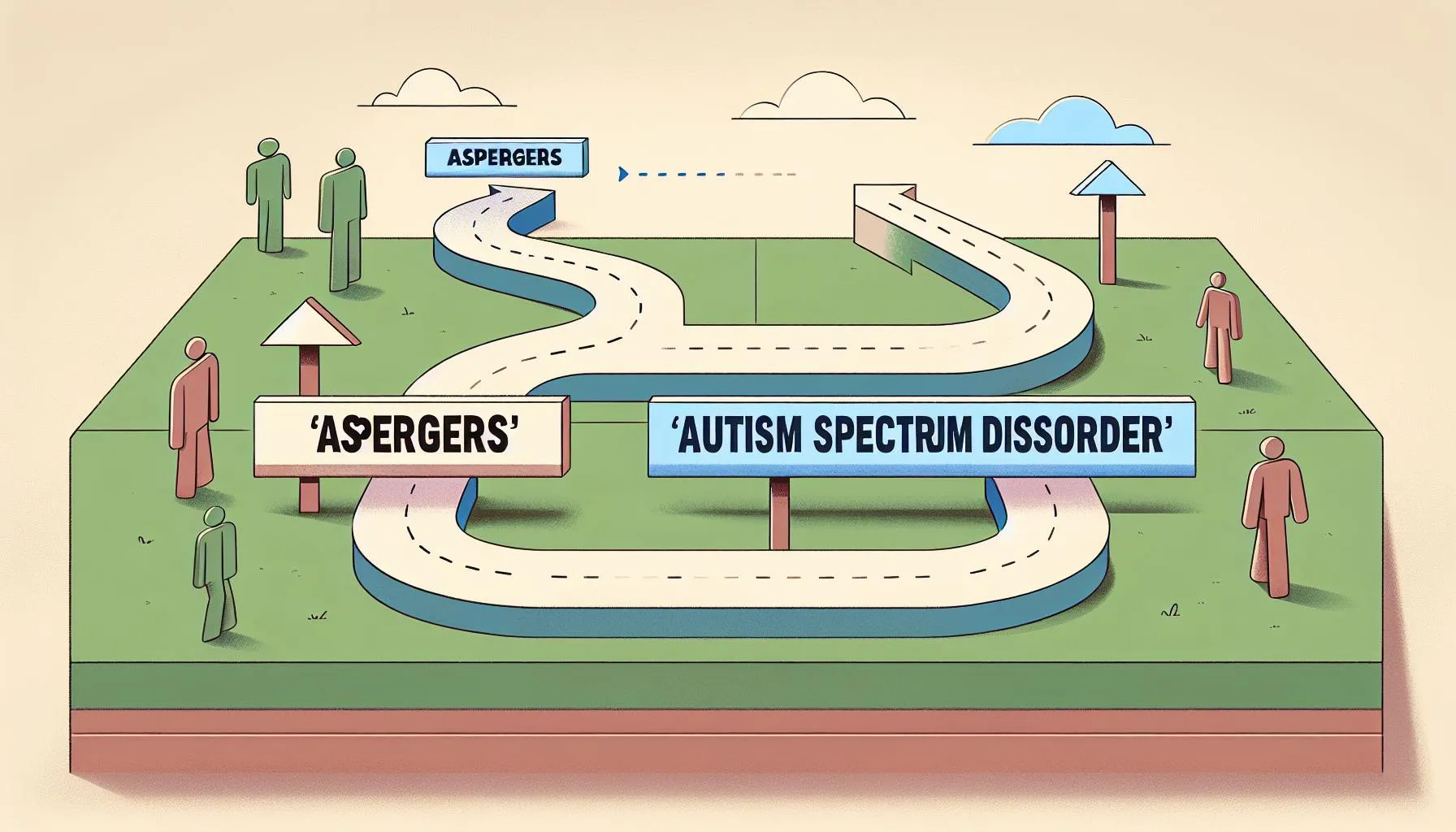The New Term for Aspergers Revealed
Discover the New Term for Aspergers! Unveiling the Evolution of Diagnostic Terminology and its Impact on the Autism Community.

Understanding Autism Spectrum Disorder
Autism Spectrum Disorder (ASD) is a neurodevelopmental disorder that affects behavior, communication, social skills, and the ability to learn. It is a broad term that encompasses a range of conditions and is characterized by challenges in social interaction, communication difficulties, and repetitive behaviors or restricted interests. Let's explore what ASD is and the different types within the spectrum.
What is Autism Spectrum Disorder?
Autism Spectrum Disorder is a condition that impacts the way individuals perceive and interact with the world around them. It is typically diagnosed in early childhood, although symptoms may be present from an early age. The exact cause of ASD is still not fully understood, but it is believed to involve a combination of genetic and environmental factors.
ASD affects people differently, and symptoms can vary from mild to severe. Some individuals with ASD may have exceptional abilities or talents in specific areas, such as music, art, or mathematics. It is important to note that ASD is a lifelong condition, but with appropriate support and interventions, individuals with ASD can lead fulfilling lives.

Types of Autism Spectrum Disorder
ASD encompasses a range of conditions that fall under the autism spectrum. As of 2013, with the publication of the fifth edition of the Diagnostic and Statistical Manual of Mental Disorders (DSM-5) by the American Psychiatric Association, the term "Asperger's syndrome" is no longer used as an official diagnosis. Instead, it has been folded into the broader category of Autism Spectrum Disorder.
Within the ASD spectrum, there are different levels based on the level of support an individual requires. The current terminology includes:
- Autism Spectrum Disorder Level 1 (ASD-1): This level indicates that an individual requires some support, but their symptoms do not significantly impact their daily functioning. They may exhibit mild social, communication, or behavioral challenges.
- Autism Spectrum Disorder (ASD): This level indicates that an individual requires substantial support due to significant challenges in social interaction, communication, and behavior. Symptoms may severely impact their daily functioning and ability to navigate social situations.
It's important to note that these levels are not meant to define a person's worth or potential. Instead, they serve as a guide to understanding the varying degrees of support individuals with ASD may require.
Understanding Autism Spectrum Disorder is crucial in providing appropriate support and interventions for individuals with ASD. By recognizing and embracing the diversity within the spectrum, we can work towards creating an inclusive society that respects and supports the unique strengths and challenges of individuals with ASD.
Evolution of the Term for Asperger's
As our understanding of autism spectrum disorders has evolved, so too has the terminology used to describe and diagnose these conditions. In this section, we will explore the evolution of the term for Asperger's syndrome, from its initial definition to the changes in diagnostic terminology.
Asperger's Syndrome and its Definition
Originally, Asperger's syndrome was named after Austrian pediatrician Hans Asperger, who first described the condition in the 1940s. Asperger's syndrome was characterized by impairments in social interaction, restricted interests, and repetitive behaviors. Individuals with Asperger's syndrome typically had average or above-average intelligence and language skills.
Changes in Diagnostic Terminology
In 2013, the fifth edition of the Diagnostic and Statistical Manual of Mental Disorders (DSM-5) was published by the American Psychiatric Association. This edition brought significant changes to the diagnostic criteria and classification of autism spectrum disorders.
As part of these changes, Asperger's syndrome was no longer recognized as a separate diagnosis. Instead, it was folded into a broader category that encompasses a wide range of autism-related conditions. The new term for Asperger's syndrome became "autism spectrum disorder" (ASD).
Under the umbrella term of ASD, different levels of severity are now identified. Autism Spectrum Disorder Level 1 (ASD-1) represents individuals who require minimal support. This level encompasses what was previously referred to as Asperger's syndrome. It is characterized by mild social and communication challenges, as well as repetitive behaviors or restricted interests [2].
The shift from the term "Asperger's syndrome" to "autism spectrum disorder" reflects a desire to provide a more comprehensive and inclusive approach to diagnosing and understanding autism-related conditions. This change aims to emphasize the shared characteristics and challenges that individuals with ASD face, while recognizing the diverse range of experiences within the spectrum.
By adopting the term "autism spectrum disorder," clinicians and researchers can better align their understanding and approach to the diagnosis and treatment of individuals with autism-related conditions. This change also helps to avoid potential misinterpretations of Hans Asperger's role in Nazi-era eugenics and euthanasia policies, as the American Psychiatric Association sought to clarify the historical context.
The evolution of the term for Asperger's syndrome reflects our growing understanding of autism spectrum disorders and the need for more accurate and comprehensive diagnostic criteria. By embracing the term "autism spectrum disorder" and its associated levels, we can continue to improve our support, understanding, and treatment for individuals on the autism spectrum.
The New Term for Asperger's
Autism Spectrum Disorder Level 1 (ASD-1)
Autism Spectrum Disorder (ASD)
In 2013, the Diagnostic and Statistical Manual of Mental Disorders (DSM-5), published by the American Psychiatric Association, introduced changes in the diagnostic terminology for Asperger's syndrome. The new term for Asperger's syndrome is Autism Spectrum Disorder Level 1 (ASD-1), which falls under the broader umbrella of Autism Spectrum Disorder (ASD) [1].
The term "Asperger's syndrome" is no longer an official diagnosis as of 2013, as it has been merged into the broader category of Autism Spectrum Disorder (ASD). This change was made to provide a more comprehensive framework that encompasses a wide range of autism-related conditions.
Autism Spectrum Disorder Level 1 (ASD-1) refers to individuals who exhibit mild symptoms and challenges associated with autism. These individuals may have difficulties with social interactions, communication, and may engage in repetitive behaviors or have restricted interests. The term "level 1" indicates the mild severity of symptoms within the autism spectrum.
Under the new terminology, Autism Spectrum Disorder (ASD) serves as the overarching term that encompasses individuals with different levels of symptom severity. This change aims to provide a clearer understanding of the diverse range of conditions that fall within the autism spectrum.
The transition to Autism Spectrum Disorder (ASD) as the new term for Asperger's syndrome has implications for diagnosis and treatment considerations. It allows for a more unified approach to understanding and addressing the challenges faced by individuals on the autism spectrum. By recognizing the spectrum nature of autism, it promotes a comprehensive understanding of the condition and supports tailored interventions and support strategies.
Additionally, the change in terminology has had an impact on the community and identity of individuals previously identified as having Asperger's syndrome. The new terminology helps to reduce misunderstandings and misinterpretations associated with the historical controversy surrounding Hans Asperger's role during the Nazi era. It provides a more neutral and inclusive framework for individuals with autism, fostering a sense of belonging and understanding.
The adoption of the new term, Autism Spectrum Disorder (ASD), reflects the evolving understanding of autism and the need for a unified approach to diagnosis and support. It acknowledges the diverse experiences of individuals on the autism spectrum and promotes a more inclusive and compassionate society.
Characteristics of Autism Spectrum Disorder
Autism Spectrum Disorder (ASD) is a neurodevelopmental disorder that affects behavior, communication, social skills, and the ability to learn. The characteristics of ASD can vary from person to person and can range from mild to severe. Here are three key features commonly associated with ASD:
Social Interaction Challenges
Individuals with ASD often experience difficulties with social interactions. They may struggle with understanding social cues, initiating or maintaining conversations, and interpreting nonverbal communication such as facial expressions or body language. As a result, they may face challenges in developing and maintaining relationships with peers and have a preference for solitary activities.
Communication Difficulties
Communication challenges are another hallmark of ASD. People with ASD may have delayed language development, difficulty understanding or using spoken language, and a tendency to take language literally. They may have trouble initiating or participating in conversations, and their speech may lack the usual rhythm and intonation. Some individuals with ASD may rely on alternative methods of communication, such as gestures, pictures, or assistive communication devices.
Repetitive Behaviors and Restricted Interests
Repetitive behaviors and restricted interests are common in individuals with ASD. They may engage in repetitive movements, such as hand-flapping or rocking, and exhibit a need for sameness and routine. Individuals with ASD may also have intense, focused interests in specific topics or objects and may become upset or agitated if their routines or interests are disrupted.
It's important to note that these characteristics can manifest in different ways and to varying degrees in individuals with ASD. Each person's experience with ASD is unique, and the severity of symptoms can range from mild to severe. Early intervention, therapy, and support can play a crucial role in helping individuals with ASD navigate these challenges and lead fulfilling lives.
By understanding the characteristics of ASD, we can promote greater awareness, acceptance, and support for individuals on the autism spectrum.
Impact of the New Terminology
The introduction of new terminology for Asperger's syndrome has had significant impacts on the diagnosis and treatment of individuals on the autism spectrum. Additionally, it has influenced the broader communities and identities associated with autism.
Diagnosis and Treatment Considerations
The shift from using the term "Asperger's syndrome" to the broader diagnosis of Autism Spectrum Disorder (ASD) has resulted in changes in the eligibility for special services and support. Previously, individuals diagnosed with Asperger's syndrome could receive specific interventions tailored to their needs. However, with the elimination of Asperger's syndrome as a separate diagnosis, individuals are now classified under the broader umbrella of ASD.
Getting the correct diagnosis is crucial for individuals with ASD, as it allows them to access appropriate interventions and support. Effective treatment strategies can help individuals with ASD lead more fulfilling lives and reach their full potential. Professionals in the field now focus on evaluating individuals based on the severity of their autism symptoms using the Autism Spectrum Disorder Level 1 (ASD-1) classification or simply ASD. This approach ensures that individuals receive the necessary support tailored to their specific needs.
Community and Identity
The change in terminology has also had an impact on the autism community and individual identities. Asperger's syndrome had become a recognized term within the community, and individuals identified strongly with this label. The elimination of Asperger's syndrome as a separate diagnosis has led individuals to reassess their identities within the broader ASD classification.
While some individuals have embraced the shift and identify themselves as being on the autism spectrum, others may feel a loss of identity or a need to redefine their sense of self. This transition can be challenging for individuals who had established connections and support networks within the Asperger's community.
It is important for society to recognize and respect the preferences of individuals when it comes to their self-identification. By fostering a supportive and inclusive environment, individuals on the autism spectrum can navigate this transition positively and continue to advocate for their rights and needs.
Understanding the impact of the new terminology on diagnosis, treatment, and identity is crucial for professionals, families, and the broader community. By staying informed and promoting acceptance, we can ensure that individuals with ASD receive the necessary support and resources to thrive.
Historical Controversy Surrounding Asperger's
The history of Asperger's syndrome is not without controversy. The person at the center of this controversy is Hans Asperger, an Austrian doctor who made significant contributions to the understanding of autism. However, recent revelations have shed light on his involvement with the Nazi regime and its euthanasia program.
Hans Asperger's Role and Controversy
Hans Asperger, in his work during the Nazi era, cooperated extensively with the Nazi regime, as uncovered by the journal Molecular Autism and the forthcoming book "Asperger’s Children: The Origins of Autism in Nazi Vienna" [5]. Asperger's involvement in the Nazi-era euthanasia program raises ethical questions and has led to a reevaluation of his contributions to the field of autism research.
It has been revealed that Asperger referred children to the Am Spiegelgrund clinic in Vienna, a facility where doctors conducted experiments on children and euthanized them with barbiturates. Disturbingly, many of the victims were disabled or sick, and at least 789 children died at the clinic during the war as a result of these practices.
Connection to Nazi-era Euthanasia Program
Asperger's involvement with the Nazi regime has raised questions about the origins of the eponymous medical term 'Asperger syndrome'. The association between Asperger and the Nazi Party, as well as his involvement in the euthanasia program, have led to suggestions that the term be discarded.
In light of these revelations, the American Psychiatric Association made a significant decision in 2013 to rebrand Asperger's syndrome as autism spectrum disorder. The purpose of this change was to disassociate the condition from the controversial history of its namesake, clarifying any misinterpretations of Asperger's role in Nazi-era eugenics and euthanasia policies.
The historical controversy surrounding Asperger's involvement with the Nazi regime highlights the importance of critically examining the origins and associations of medical terms. It serves as a reminder of the ethical considerations that should guide the understanding and treatment of individuals with autism spectrum disorder.
The New Term for Asperger's
In 2013, the diagnostic terminology for Asperger's syndrome underwent a significant change. The new term used to describe this condition is Autism Spectrum Disorder Level 1 (ASD-1), according to the fifth edition of the Diagnostic and Statistical Manual of Mental Disorders (DSM-5) published by the American Psychiatric Association. This change reflects a shift in the understanding and classification of autism-related conditions.
Autism Spectrum Disorder Level 1 (ASD-1)
ASD-1 is now the preferred term for what was previously known as Asperger's syndrome. It falls under the broader category of Autism Spectrum Disorder (ASD), which encompasses a range of conditions involving social and communication challenges. The new terminology aims to provide a more comprehensive understanding of the condition and its various manifestations.
Autism Spectrum Disorder (ASD)
The term "Asperger's syndrome" is no longer an official diagnosis as of 2013. It has been merged into the broader category of Autism Spectrum Disorder (ASD). This change recognizes the overlapping characteristics and shared challenges among individuals on the autism spectrum.
The reclassification to ASD reflects the understanding that autism is a spectrum, with varying degrees of impairment and support needs. By grouping conditions under the umbrella of ASD, it allows for a more comprehensive approach to diagnosis, treatment, and support for individuals with different presentations of autism.
The decision to update the terminology was not only based on clinical considerations but also on addressing historical controversies surrounding the original label of Asperger's syndrome. The rebranding aimed to disassociate the condition from any misinterpretations of Hans Asperger's role in Nazi-era eugenics and euthanasia policies, providing a clearer and more neutral framework for understanding and addressing autism-related conditions.
Understanding the new term for Asperger's, Autism Spectrum Disorder Level 1 (ASD-1), enables individuals, families, and healthcare professionals to better navigate the diagnosis, treatment, and support options available. By recognizing the broader spectrum of autism-related conditions, it opens up opportunities for tailored interventions and support services to meet the unique needs of individuals with ASD.
References
- https://www.webmd.com/brain/autism/mental-health-aspergers-syndrome
- https://en.wikipedia.org/wiki/Asperger_syndrome
- https://www.vox.com/conversations/2018/5/22/17377766/asperger-nazi-rename-syndrome
- https://www.healthline.com/health/autism/why-is-the-term-aspergers-no-longer-used
- https://www.spectrumnews.org/news/new-evidence-ties-hans-asperger-nazi-eugenics-program/
Does Your Child Have An Autism Diagnosis?
Learn More About How ABA Therapy Can Help
Find More Articles
Contact us
North Carolina, Nevada, Utah, Virginia
New Hampshire, Maine
Arizona, Colorado, Georgia, New Mexico, Oklahoma, Texas
.avif)




































































































